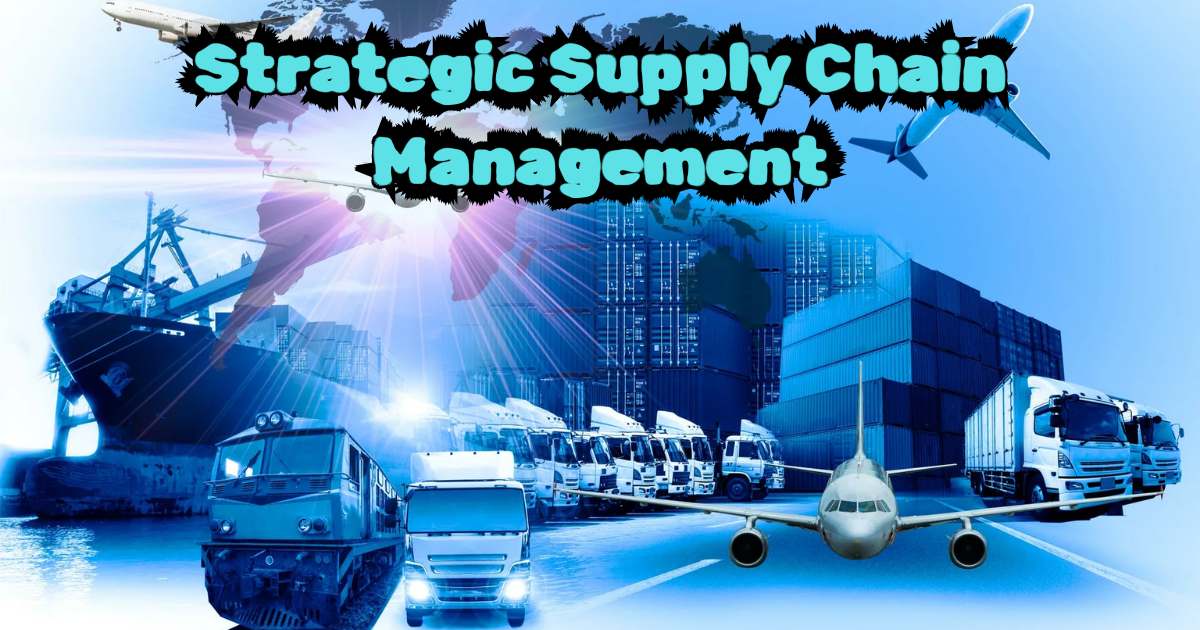Imagine having the power to perfectly synchronize every aspect of your supply chain with your company’s overarching mission, goals, and vision.
That’s the incredible potential of strategic supply chain management. With this approach, you can transform your logistics operations from a necessary cost center into a competitive advantage that drives growth and profitability.
According to a recent Gartner study, companies with robust strategic supply chain management practices generate 20% more revenue from new products and services than their less strategic peers. That’s a game-changing impact no business can afford to ignore.
Clearing up What Strategic Supply Chain Management Actually Is
The phrase “strategic supply chain management” gets tossed around frequently, but what does it actually mean? At its core, it’s about distinguishing between tactical actions and high-level strategy.
Think of it like a coach drawing up the game plan (strategy) versus the players executing specific plays on the field (tactics). The military makes a helpful distinction:
Strategy is the overarching plan to achieve major objectives by integrating various components in a synchronized way. It’s the big-picture thinking required to outmaneuver obstacles and uncertainties.
Tactics are the specific actions and ordered arrangements of resources undertaken to accomplish each strategic step along the way.
Operations bridge the gap between strategy and tactics through sequences of tactical actions with a unified purpose, like logistics management.
So in the supply chain context, strategic supply chain management involves two interconnected elements:
- Aligning supply chain operations to support the organization’s broader strategic goals and plans.
- Developing and executing big-picture strategies to optimize the supply chain itself through procurement, logistics, sourcing, and delivery.
Having a clear understanding of this distinction is crucial for designing, coordinating, and assigning supply chain activities appropriately.
Why Getting the Strategy Right Matters
Getting supply chain strategy wrong can be disastrous. For example, Chinese manufacturing costs rose 187% between 2000-2008, yet many companies remained heavily reliant on Chinese suppliers due to inertia.
This strategic supply chain blindspot left them struggling to adapt when labor costs skyrocketed.
On the other hand, Apple’s mastery of strategic supply chain management is a big reason for its dominance. The company’s supply chain operates with:
- Low inventory levels through just-in-time practices
- Massive purchasing power to keep supplier costs down
- Dual-sourcing of components to reduce supply disruptions
- Air freight capabilities for rapid product launches
Thanks to these and other strategic plays, Apple generates over $630 billion in annual revenue from premium products that competitors can’t match.
How Strategic Supply Chain Management Supports Larger Corporate Strategies
While supply chain excellence is powerful on its own, the real impact comes from supporting and enabling broader corporate strategies. Supply chain executives play a pivotal role in developing these organizational game plans.
For example, a company may decide to:
Reshore production capacity closer to end customers to increase control and reduce lead times, despite higher labor costs.
Switch to just-in-time manufacturing by redesigning products with fewer parts and streamlined sourcing to minimize inventory overheads.
Invest in sustainability initiatives like energy-efficient facilities, renewable supply sources, and green transportation to improve environmental performance.
In each case, the supply chain implications are massive – which is why supply chain leaders need a seat at the strategy table. Their innovative supply chain management strategies are vital for translating corporate visions into operational realities.
Supply Chain Strategy in Action: Starbucks Revamps to Fuel Further Growth
A powerful example of strategic supply chain management in action is Starbucks’ major overhaul during the Great Recession. Despite its global brand power, Starbucks was reeling by late 2008 as customers cut back on pricey espresso drinks.
“We were being beaten by a strong economic headwind of historical proportions. Sales were slowing, while operational costs were growing.” – Howard Schultz, Starbucks CEO
Something dramatic had to change. The solution? Dramatically reorganizing and optimizing Starbucks’ entire supply chain through moves like:
- Streamlining to four core units: Planning, sourcing, production, and delivery to increase focus and efficiency.
- Adding a new regional production plant closer to customers in South Carolina to reduce transportation costs.
- Performing a comprehensive analysis of global logistics costs and transportation links to find cost-saving opportunities.
- Renegotiating supplier contracts by re-evaluating and replacing underperforming 3PL logistics providers.
This strategic supply chain transformation didn’t just save money – it fundamentally increased Starbucks’ agility and competitiveness.
Streamlined operations positioned the brand to expand into new markets, drive sustainable sourcing practices, and rapidly launch innovative products like the Pumpkin Spice Latte.
Strategic Planning Itself Supports Supply Chain Operations
In addition to enabling broader corporate strategies, strategic planning is vital within the supply chain organization itself.
While still operating at an operational level, supply chain leaders must think and act strategically about activities like:
- Determining the structure and flow of the entire logistics train from end-to-end
- Evaluating and selecting procurement models (single vs multi-sourced, near vs offshore, etc.)
- Choosing locations for logistics hubs to optimize inventory stocking levels
- Deciding transportation modalities (truck, air, rail, maritime) for product distribution
- Developing supporting infrastructure for communications, data visibility, quality control and more
Each of these supply chain strategy decisions requires carefully considering factors like:
- Cost-benefit analysis of different options using total landed cost models
- Risk mitigation planning for potential disruptions, supplier issues, or demand fluctuations
- Competitive environment analysis to proactively adapt to evolving markets and threats
- Capital and resource allocation to align spending with strategic priorities
Essentially, supply chain leaders must take a highly analytical, cross-functional view – scrutinizing data from finance, sales, marketing and operations.
Their supply chain strategic planning lays the operational groundwork to execute corporate strategy reliably and cost-effectively.
Data-Driven Decision Making is Critical
In our data-driven era, effective strategic supply chain management is impossible without robust data analysis capabilities.
Supply chain planners must be able to synthesize information from myriad sources to gain an accurate, holistic view.
For example, when deciding to open a new distribution center, key data points may include:
- Geo-mapped customer/demand analysis to determine optimal location
- Workforce analytics around local labor costs and availability
- Logistics cost modeling for inbound material flows and outbound delivery routes
- Tax and regulatory research on compliance requirements and incentives
By mastering tools like descriptive and predictive analytics, supply chain teams can run sophisticated simulations to pressure-test strategic options before implementing.
This data-driven decision making is what separates strategic leaders from tactical operators.
Supply Chain Strategy Without Education Is Nearly Impossible
Developing world-class strategic supply chain capabilities is incredibly difficult without formal education and training.
That’s why most senior supply chain roles require at minimum a Master’s in Supply Chain Management or an MBA with a Supply Chain concentration.
These advanced degree programs equip students with strategic skills like:
Economic analysis for evaluating production tradeoffs and procurement decisions based on factors like labor rates, materials costs, trade policies and more.
Market intelligence and forecasting to understand demand signals, identify potential disruptions or opportunities, and adjust strategic planning accordingly.
Project management fundamentals for developing realistic roadmaps, allocating resources appropriately, managing risk and coordinating cross-functional activities.
Strategic communication abilities to clearly convey complex initiatives throughout the organization and influence decision-makers.
Most programs incorporate real-world case studies, simulations, and internship experiences. This experiential learning is crucial, as even the most brilliant strategy rarely survives first contact with the market unscathed. Continuous monitoring and iterative optimization are necessary.
“You can have data territory that isn’t a frontier. You can have maps, but you have to be able to map and re-map.” – Kevin Dettinger, Director of Supply Chain Operations Program at Portland State University
Ultimately, while raw talent and experience are valuable, there’s no substitute for dedicated supply chain strategy education. As strategies grow more complex in our dynamic global economy, this formalized training will only become more essential.
Also Read This Post:
Final Thoughts
In today’s hyper-competitive business landscape, mastering strategic supply chain management is truly a game-changing opportunity.
By aligning logistics operations with corporate objectives and developing innovative supply chain strategies, companies can transform their supply chain from a cost burden into a crucial competitive advantage.
Whether it’s fueling growth by reshoring production closer to customers, minimizing costs through lean just-in-time practices, or driving sustainability initiatives – strategic supply chain management underpins success.
However, getting strategy right is enormously challenging. It requires a rare convergence of cross-functional expertise, mastery of advanced data analytics, and the ability to translate big-picture vision into granular operational plans that can be executed flawlessly.
That’s why pursuing formalized education in supply chain strategy is so vital. Degree programs and industry certifications provide the intensive training needed to develop these specialized skills and competencies.
From economic modeling to project management, market forecasting to strategic communication – the knowledge gained is invaluable.
But book learning is just the start. Supply chain strategy is truly an art that must be continually honed through real-world experience, iterations and a voracious appetite to adapt.
As the great strategist Sun Tzu is oft-quoted, “In the midst of chaos, there is also opportunity.”
For forward-thinking businesses prepared to master strategic supply chain management, that opportunity is to leave competitors behind and claim durable advantages in cost, service, quality and innovation.
It’s a challenging journey, but one leading to transformative competitive gains. The future favors the bold willing to elevate supply chain strategy as an organizational priority.

With a wealth of expertise spanning 6 years, I am a seasoned author in the realm of courier services information. My insights illuminate the intricacies of logistics and delivery solutions.











